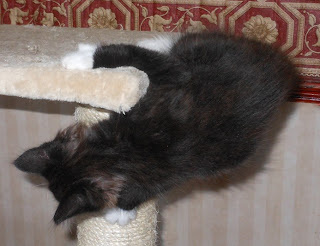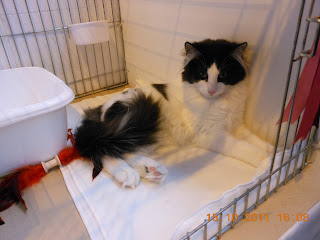To answer this question in one word, it is
inbreeding. However the word inbreeding has unpleasant connotations,
particularly to the layman, so line breeding is a phrase used by breeders who
practice this. Basically any cat that is mated to a relative is being line
bred. A lot of people – especially novice breeders– shy away from this idea.
This may be because, in human terms, any mating between close family members is
frowned upon and indeed seems slightly horrific. Some of this distaste may rub
off onto our views about cat breeding. However it can be a useful tool when
used intelligently. Moreover, cats have no such compunction and mums are happy
to mate with sons, grandfathers with granddaughters and so on. Obviously what
cats are happy to do and what is in the breed’s interest does not always
coincide. In the following article I will use the term “inbreeding” rather than
line breeding as I feel it is more honest. I'm not into inbreeding my cats in a big way myself and use frequent outcrosses, but sometimes having a really good ancestor on both sides of the pedigree can produce wonderful kittens, so long as health is always top of the list of priorities.
 |
| Quink as a 'teenager' |
Let us look at Quink's pedigree as an example. His pedigree name is Quil Gyldenloeve. Because he has a very short pedigree he is on the 'reference register' for GCCF. You only have to go back three generations to find a 'novice' - ie a cat from the forest (Champion Putte), of unknown ancestry.
So we don't know if Putte is inbred or not. We can but hope! The rest of the pedigree looks as though there are no other cats appearing more than once - so he seems to have no inbreeding at all. However if you go back... and back... and back to the ends of all the lines in his pedigree, you can see that a few cats do appear more than once after all. It's very slight though.
So what
happens if you avoid inbreeding?
Well, for a start, in the
world of Norwegian Forest Cats it is very difficult to avoid some measure of
inbreeding as some cats (particularly well-used stud cats) appear in pedigrees
time and time again, albeit possibly so far back in the pedigree that the
breeder may not realise without special research. This is in spite of NFCs having one of the widest gene pools of all breeds. In my opinion, some of the early breeders of Forest Cats in Norway did repeated matings of very closely related cats, to an extreme extent, and that is not something I would like to see happen again. A certain amount of diluted inbreeding is seen in many breeds and so long as the common
ancestor(s) do not have health or temperament problems then it is harmless.
However if one tries to have little or no inbreeding in a pedigree then what
happens is that the results of a mating are very unpredictable. That is why
there are huge variations within the NFCs in this country and indeed worldwide.
There are also enormous variations within individual litters. Experienced
breeders are often pleased when they have some sort of uniformity within a
litter and within litters of repeat matings. Sometimes they are fooled when the
kittens are all one colour and pattern however! Otherwise breeding NFCs amounts
to little more than a lottery. I have seen (both in my own cattery and in
others) cases of large parents producing small offspring; small parents
producing good-sized offspring; two cats with dipped profiles producing kittens
with straight profiles; and vice versa, and so on. It always amazes me how
variable NFCs are, after I bred Abyssinians for some years with very
predictable and consistent results. The latter is probably due to a much
smaller gene pool in the breed as a whole – something that has its advantages
and disadvantages.
 |
| Vieuxtemps Indigo |
We once had an 'oops' mating that resulted in father-daughter progeny! This was when Magnus had been neutered but was still fertile. He was mistakenly allowed to reach his daughter and, sod's law, they mated. The result was two lovely and very similar blue tabby kittens, Indigo and Indiana.
 |
| Champion Magnus More og Romsdal, father of Indigo |
A father-daughter mating certainly wasn't what I had had in mind, but the kittens were robust and beautiful so no harm was done on that occasion.
What
happens if you avoid inbreeding to a large extent, is inconsistency and unpredictable
type. Resulting litters are likely to be healthy and large but may have hidden
recessive defects.
We are fortunate to have a large
gene-pool for the NFC breed, worldwide and also within the UK. This means that
we have a wide choice from which to pick and choose the best of the cats
available to breed on from. Of course this doesn’t always happen as some
breeders use cats for breeding merely for reasons of convenience or
sentimentality. However we are in a better position than many breeds when it
comes to diversity of breeding stock. So should we make a point of capitalising
on this fact and doing as many outcrosses as possible in our breeding? To
answer this question we need to know the answer to another:
What happens if you do practice inbreeding (and
probably call it line breeding)?
There are some good things to be
said for inbreeding. The obvious one is that litters become more consistent. If
a cat is “doubled up” in a pedigree then that cat’s characteristics will have a
doubly strong influence. When a cat is considered a particularly brilliant
example of a breed then sometimes it appears in a cat’s pedigree many times. I counted
the repetition of one such “super cat” in a UK pedigree and it appeared 13
times in just a few generations! Before you drawback in horror let me also say
that the cat whose pedigree I mention is actually a reasonable size (as far as
I can tell from looking as I haven’t handled him), healthy and very successful
for a number of years both on the show-bench and as a stud. Hence in this
instance the inbreeding cannot really be faulted even if most of us would avoid
such extreme practice.
Another benefit of inbreeding is
that, if there is a recessive genetic fault in a cat, then it will very likely
be revealed in the inbred offspring. I remarked above that a cat who is doubled
up in a pedigree will have double influence on the genes (depending on how far
back the doubling up occurs, of course). Let us take as an example the father-daughter mating I had many years ago, by mistake.
The father had no known genetic defects and was a healthy, good-looking cat.
However he may have had a recessive fault. If that had been the case then that
fault would only “show up” if his mate carried the same fault. With unrelated
mates this would be unlikely. Some genetic defects can be secretly carried for
generations just because the cat with the recessive (hidden) defect has never
been mated with a cat also carrying the same recessive defect. If you have a
doubt whether or not a cat is carrying a recessive defect then you can check it
out by repeating the suspected carrier in a pedigree. If no kittens in the
resulting litter have that defect it is very likely that the suspected cat is
free from the defect. That is
fortunately what happened with my “oops” mating mentioned above.
So, with inbreeding, the faults
but also the good points are doubled up in the progeny. Hence if a cat with a
very strong chin, for instance, is repeated within a pedigree twice or more
times, then that strong chin is more and more likely to appear in the kittens.
Something happens that we call “fixing” a characteristic; and if intelligent
line-breeding has taken place over a number of generations with the breeding
stock carefully selected from each generation, then the “look” of that line is
firmly entrenched and is likely to be passed on even to the offspring of an
outcross mating.
 |
This Vieuxtemps litter brother and sister, from completely
unrelated parents, are inconsistent in type |
To sum up, the benefits of
inbreeding are discovery and hence elimination of any hidden genetic defects,
together with a consistent and distinctive “look”.
If inbreeding has been carried
out then it is wise to use outcrosses frequently also. An outcross is a mate
with very few or no shared ancestors. Repeated inbreeding can cause “inbreeding
depression” meaning not that the cats go moping around miserably, but that
individual kittens and also numbers in litters decrease in size. If you mate
two very closely related parents, even if those parents are huge cats,
offspring are likely to be smaller.
Conversely, an outcross can immediately restore the size of the
individual and the size of the litter (assuming that the individuals concerned
are large and fertile of course). This phenomenon is known as “hybrid vigour”.
If you look at the pedigrees of
famous and successful breeders here and abroad (for example, the Pan’s cats of
Norway and Jette Madsen’s world-winning Felis Jubatus lines from Denmark) you
will see that they have carried out inbreeding but also included plenty of
healthy outcrosses. If a cat has been extensively used and repeated in
pedigrees – Pan’s Polaris is perhaps the most famous example – then it is
fairly certain that that cat has no genetic health problems if these have not
shown up in multiple progeny.
 |
My previous stud cat, Dansbjergs Pelle Halelos as a youngster.Pelle had been purposely line bred to 'fix' some excellent characteristics
and as a result his litters were very predictable and beautiful. |
 |
| Vieuxtemps Vantage Vroom, Pelle's son, was from a complete outcross mating yet looks very like his father due to Pelle's specially bred 'fixed' look.Vroom has done very well on the showbench. |
So
what should breeders do? My own experience of this is that I have done both
inbreeding and complete outcrosses. With the inbreeding I have immediately
seen a particular “look” which more or less replicates the look of the cat
that was repeated in the pedigree. Naturally I have used cats that I really
like as “repeats” so the resulting look is therefore one that pleases me.
When I imported my stud Pelle (above, now retired) I chose him because he comes from
completely different lines from my existing cats. It was time for a thorough
outcross. However he came from a breeder who has, over many years, performed
careful and intelligent inbreeding so that her cats have a distinct “look” incorporating
the features she considers important in the Norwegian Forest Cat. This has
been done so effectively that I find that kittens from that stud, resulting
from unrelated females of mine and other people’s, tend to carry on his
distinctive and predictable “look”. This is because the stud has fixed
characteristics due to the way his pedigree was planned. Of course, his bad as
well as his good points are likely to be fixed – fortunately he appears to have
no genetic defects. I feel my own way forward would be to continue to combine
inbreeding with outcrosses in an attempt to maintain the “look” whilst at the
same time achieving hybrid vigour. Of course breeding high quality cats is
easier said than done, which is all part of the fun. I am writing this article to clarify what the
good and bad sides of inbreeding are, and to dispel the myth that all inbreeding
is a bad thing. It can be a good thing too – in moderation.













































